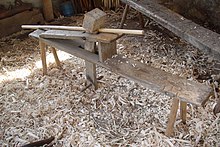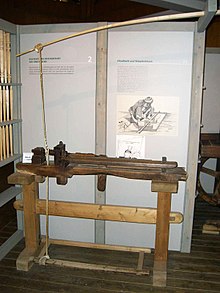
A lathe is a machine tool that rotates a workpiece about an axis of rotation to perform various operations such as cutting, sanding, knurling, drilling, deformation, facing, threading and turning, with tools that are applied to the workpiece to create an object with symmetry about that axis.
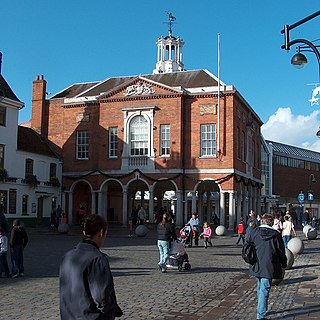
High Wycombe, often referred to as Wycombe, is a market town in Buckinghamshire, England. Lying in the valley of the River Wye surrounded by the Chiltern Hills, it is 29 miles (47 km) west-northwest of Charing Cross in London, 13 miles (21 km) south-southeast of Aylesbury, 23 miles (37 km) southeast of Oxford, 15 miles (24 km) northeast of Reading and 8 miles (13 km) north of Maidenhead.
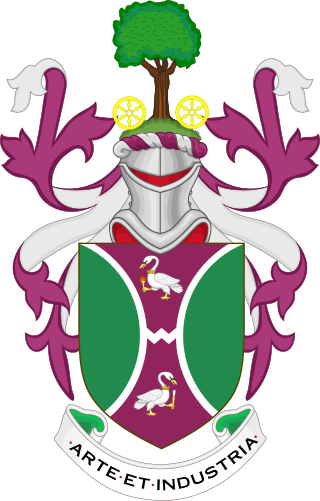
Buckinghamshire New University (BNU) is a public university in Buckinghamshire, England, with campuses in High Wycombe, Aylesbury, Uxbridge and Great Missenden. The institution dates from 1891, when it was founded as the School of Science and Art, and has since then has variously been known as Wycombe Technical Institute, High Wycombe College of Technology and Art and the Buckinghamshire College of Higher Education. It was a university college from 1999 until 2007, when its application for university status was accepted.

Woodturning is the craft of using a wood lathe with hand-held tools to cut a shape that is symmetrical around the axis of rotation. Like the potter's wheel, the wood lathe is a mechanism that can generate a variety of forms. The operator is known as a turner, and the skills needed to use the tools were traditionally known as turnery. In pre-industrial England, these skills were sufficiently difficult to be known as "the mysteries of the turners' guild." The skills to use the tools by hand, without a fixed point of contact with the wood, distinguish woodturning and the wood lathe from the machinist's lathe, or metal-working lathe.

A drawknife is a traditional woodworking hand tool used to shape wood by removing shavings. It consists of a blade with a handle at each end. The blade is much longer than it is deep. It is pulled or "drawn" toward the user.

A pole lathe, also known as a springpole lathe, is a wood-turning lathe that uses the resilience of a long pole as a return spring for a treadle. Pressing the treadle pulls on a cord that is wrapped around the piece of wood or billet being turned. The other end of the cord reaches up to the end of a long springy pole. As the action is reciprocating, the work rotates in one direction and then back the other way. Cutting is only carried out on the down stroke of the treadle, the spring of the pole only being sufficient to return the treadle to the raised position ready for the next down stroke. Bungee cords are sometimes used as a modern replacement for springpoles. A bungee cord can function within a smaller space but the pole lathe still rotates in two directions and cutting is only possible on the downstroke.

A framer is someone who builds or creates frames. In construction work, frames may be built from wood or metal and provide support and shape to a structure. In a related sense, framers may create frames for art works, pictures, or mirrors. The term framer is also used for the authors of a formal text such as a constitution.

A Windsor chair is a chair built with a solid wooden seat into which the chair-back and legs are round-tenoned, or pushed into drilled holes, in contrast to other styles of chairs whose back legs and back uprights are continuous. The seats of Windsor chairs are often carved into a shallow dish or saddle shape for comfort. Traditionally, the legs, stretchers, and uprights were usually turned on a pole lathe. Spindles may also be carved, using drawknives and spokeshaves. The back and sometimes the arm pieces are formed from steam bent pieces of wood. Traditional Windsors are typically painted, primarily to hide the different types of wood used in construction, based on their characteristics.
A spindle, in furniture, is a cylindrically symmetric shaft, usually made of wood. A spindle is usually made of a single piece of wood and typically has decoration fashioned by hand or with a lathe. The spindle was common at least as early as the 17th century in Western Europe as an element of chair and table legs, stretchers, candlesticks, balusters, and other pieces of cabinetry. By definition, the axis of a spindle is straight; hence, for example, a spindle-legged chair is a straight-legged design, even though cylindrical symmetry allows decoration of elaborate notches or bulbs, so long as the cylindrical symmetry is preserved.

The forms of Chinese furniture evolved along three distinct lineages which date back to 1000 BC: frame and panel, yoke and rack and bamboo construction techniques. Chinese home furniture evolved independently of Western furniture into many similar forms, including chairs, tables, stools, cupboards, cabinets, beds and sofas. Until about the 10th century CE, the Chinese sat on mats or low platforms using low tables, but then gradually moved to using high tables with chairs.

Turned chairs — sometimes called thrown chairs or spindle chairs — represent a style of Elizabethan or Jacobean turned furniture that were in vogue in the late 16th and early 17th century England, New England and Holland. In turned furniture, the individual wooden spindles of the piece are made by shaping them with chisels and gouges while they are being turned on a lathe. Joiners or carpenters who made such furniture were termed "turners", or "bodgers", hence the surname Turner. Today, turned chairs — as well as various turned decorative elements — are still commonly made, but by machines rather than by hand.

A shaving horse is a combination of vice and workbench, used for green woodworking. Typical usage of the shaving horse is to create a round profile along a square piece, such as for a chair leg or to prepare a workpiece for the pole lathe. They are used in crafts such as coopering and bowyery.
The High Wycombe Chair Making Museum in High Wycombe, England, houses a collection of antique tools, and explains the process of how the bodgers worked in the woods through to the finished Windsor chairs. It is now run as a community interest company.
George Lailey (1869–1958) was a craftsman from the United Kingdom, noted as the last professional practitioner of the traditional craft of bowl-turning using a pole lathe.

A stool is a raised seat commonly supported by three or four legs, but with neither armrests nor a backrest, and typically built to accommodate one occupant. As some of the earliest forms of seat, stools are sometimes called backless chairs despite how some modern stools have backrests. Folding stools can be collapsed into a flat, compact form typically by rotating the seat in parallel with fold-up legs.

Ancient furniture was made from many different materials, including reeds, wood, stone, metals, straws, and ivory. It could also be decorated in many different ways. Sometimes furniture would be covered with upholstery, upholstery being padding, springs, webbing, and leather. Features which would mark the top of furniture, called finials, were common. To decorate furniture, contrasting pieces would be inserted into depressions in the furniture. This practice is called inlaying.

Philip Clissett was a Victorian country chairmaker who influenced and inspired the English Arts and Crafts Movement through various architects and designers. His chance meeting with James MacLaren has been described as "undoubtedly a seminal point in the subsequent development of the Arts and Crafts Movement", and led to the furnishing of the meeting room of the Art Workers Guild with a large number of his chairs which can still be seen today. These chairs have been "highly influential", having been "seen by almost everyone involved in art and design from the late 1880s". They particularly influenced Ernest Gimson who, in 1890, spent six weeks with Clissett learning to make ladderback chairs. Clissett's chairs were popular with the Arts and Crafts cognoscenti, and were used by Charles Rennie Mackintosh in early commissions, and by the architectural team of Richard Barry Parker and Raymond Unwin. They were also used as part of the original furnishing of the Passmore Edwards Settlement at Mary Ward House, 5 Tavistock Place, London by the architects A. Dunbar Smith and C. Cecil Brewer.
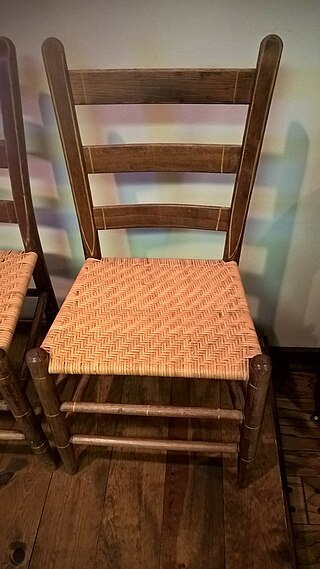
A ladderback chair, also ladder-back chair, slatback chair or fiddle back although that name is used less now due to the creation of the fiddle back chair. It gets its name from the horizontal spindles that serve as the back support on them and are reminiscent of a ladder.
Jennie Alexander was an American woodworker considered a pioneer in the woodworking world, "Instrumental in designing the now iconic two-slat post-and-rung shaving chair." She also coined the term "greenwoodworking" as a single word in her book, Make a Chair from a Tree: An Introduction to Working Green Wood.
